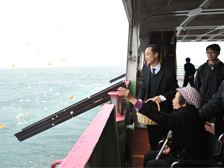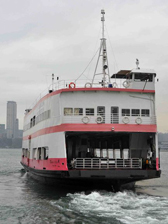
Homeward bound:
Mrs Fong scatters her husband’s ashes at sea, realising his final wish.

Farewell journey:
The 200-seat ferry for scattering cremains at sea provides a stable and comfortable environment.

Online tributes:
On board the ferry, Food & Environmental Hygiene staff assist family members to create personalised memorial pages for the deceased.
Burial at sea a loving farewell
April 04, 2012
Scattering cremated ashes at sea is a sombre and dignified send-off for a loved one. The ocean is a vast final resting place, and the gentle lapping of the waves brings comfort to the grieving.
For 73-year-old Mrs Fong, the decision to scatter her husband’s cremains from a ferry operated by the Food & Environmental Hygiene Department was his. She embarked in her wheelchair, clutching a small bag containing his ashes, with their son at her side.
“He loved the sea,” she said. “My husband belonged to the sea, so he wanted a burial at sea.”
Mr Fong was born in the South Pacific island nation of Fiji. His father had a successful business constructing freighters. When he came to Hong Kong as a young man, Mr Fong followed in his footsteps and developed his own successful shipbuilding business.
“As soon as my father learned of the department’s service for scattering cremains at sea, he asked me to arrange this for him when he was gone,” his son Charles said.
“The sea is like our home. He is going home,” he said.
The number of people choosing to scatter cremains at sea has increased fourfold over the past five years, from about 160 in 2007 to 660 in 2011. The department began providing free ferry services for scattering cremains at sea in 2010, and since then, more than 1,200 families have used the service.
It initially hired a vessel with a maximum capacity of 100 people. As demand grew, in January it began hiring a vessel with double that capacity.
Eternal voyage
Mrs Wong joined the voyage with her husband’s ashes in hand. In life, he had enjoyed travelling and had asked her to scatter his cremains at sea.
“He said he could travel on the ocean currents of the world until the end of time,” she said.
She had considered renting a yacht to send off his cremains, but that was beyond her budget. She welcomed the department’s move to a bigger boat as she thought she might get seasick on a smaller one.
“This vessel is good and the service is free. It lessens our burden,” she said.
On board the ferry, Food & Environmental Hygiene officers help family members to create personalised online
memorial pages for the deceased, another welcome convenience.
“Family members don’t have to visit the grave during Ching Ming, but can pay tribute to him anywhere and at any time, online,” Mrs Wong noted after creating an Internet tribute page for her husband.
Final wishes realised
Funeral director Alex Cheng assists loved ones with onboard memorial ceremonies. They then scatter cremains and fresh petals into the sea.
Mr Cheng has been a funeral director for 18 years, the last two of them working with the department at sea. It was quite a challenge as he used to get seasick and needed to take pills before departing. He no longer needs them following the move to a larger ferry.
He and his colleagues have tried many ways to refine the service, to help families pay their utmost respect to the deceased.
“People used to scatter the ashes by hand at the beginning. We then made a wooden trough for the families to slide the ashes into the sea, as it is a Chinese tradition that the deceased must pass through wood before leaving [this world].”
They then decided to put the ashes into a biodegradable bag so no ash residue would remain in the trough, Mr Cheng said, adding he derives great satisfaction from his work.
“People thank me for helping them to realise the wishes of their loved ones. I find my job very meaningful.”